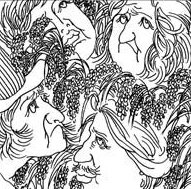Spot the real elephants in the field
By Ravi S. Narasimhan (China Daily)
Updated: 2008-05-09 07:23
Updated: 2008-05-09 07:23

I eat rice once a day. Cracked wheat or millet - whose prices have not risen much - make up the other meals as part of an attempt at a healthier lifestyle.
Ditto my mother, brother and sister. Since we live in four different countries, I am not sure about the correlation between our dietary habits and grain economics.
I avoid red meat as much as I can (again, health). Ditto most friends spread across China and India (the rest of my family is vegetarian).
I eat less than I used to (again, health). Ditto most people I know.
So surely we can't be blamed for soaring grain prices around the world.
But a string of recent statements by top Western leaders blaming China and India for food price rises provide plenty of food for comment.
US Secretary of State Condoleezza Rice started the blame game by pointing at rising prosperity in both the countries for soaring food prices.
Last Friday, US President George W Bush weighed in - and almost damning with faint praise - said of India: "... When you start getting wealth, you start demanding better nutrition and better food. And so demand is high, that causes the price to go up..."
And on Tuesday, the European Union joined in, targeting China and India for driving food prices worldwide, saying the huge increase in demand in these two countries was like an "elephant" (in the room).
EU Commissioner for Agriculture and Rural Development Mariann Fischer Boel said changes in dietary habits in China and India were responsible for spiraling global food prices.
"Those who see biofuels as the driving force behind recent food price increases have overlooked not just one elephant standing right in front of them, but two ... these countries are eating more meat," she said.

This chorus seems aimed at getting the world fretting about imaginary elephants - China is largely self-sufficient in grain production (imports mainly soybean) and India is a rice exporter (imports wheat to make up shortfall). Both are net food exporters.
So what are the real elephants?
First, the big white elephant: Biofuels.
The US and the EU are committed to huge biofuel programs, which suck in huge amounts of grain and subsidies.
Data from the UN's Food and Agricultural Organization (FAO) show that the consumption of cereals (wheat, rice, maize, corn and so on) is growing far more rapidly in the US than in China or India.
The share of the US, the FAO report said, has gone up from 13.46 percent in 2006-07 to 14.74 percent. The FAO noted that China's share is projected to have come down from 18.53 percent to 18.48 percent; and that India is estimated to have consumed 9.37 percent of world cereals in 2007-08, almost the same as 9.36 percent in the previous year. The FAO data also show that the usage of corn in the US to make biofuel increased two-and-a-half times between 2000 and 2006.
So the imaginary elephants of China and India make for a good diversion. For the record, China last year - presciently fearing shortages and rising prices - banned biofuel production which uses food crops.
Let's look at another elephant, a green one. Bush conceded that bad weather had a part to play in food shortages - but if the country with by far the highest per capita emissions had taken a leading role in fighting climate change - and transfer of technology to poorer nations - maybe agricultural production could have fared better.
Maybe it's time for the world to stop worrying about rising prosperity in China and India driving up food prices; and focus on how it can help the 100 million people the World Bank warns could be pushed deeper into poverty because of food prices.
E-mail: ravi@chinadaily.com.cn
(China Daily 05/09/2008 page8)
|
|
|
|